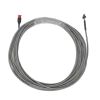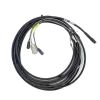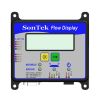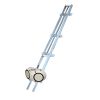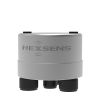SonTek-SL Series Side-Looking Doppler Current Meters
Features
- Accurate & reliable water velocity, level, & discharge measurements
- Measurements are made in a remote sampling volume free from flow distortion
- 3G model offers 128-cells for high-resolution and detailed profiles
- Expedited repair and warranty service
- Lifetime technical support
- More
Overview
The SonTek-SL (affectionately known as the Side-Looker or "SL") has earned worldwide acceptance as a long-term monitoring solution. Now, with two new (3G) models turbo-charged by the proprietary SmartPulseHD, the SonTek-SL features accessories, mounting options, software, and a variety of integration formats to ensure it fits the desired application.
Design
Designed specifically for side mounting on bridges, canal walls, or riverbanks, the SL's sleek, low-profile housing makes installation easy. With three models to choose from, the SL can be used in wide or narrow channels. Ultra narrow beam widths combined with unmatched side lobe suppression provide the superior acoustic directivity necessary for achieving maximum horizontal range free of interference from surface or bottom boundaries.
Mechanics
First time users can collect test data within minutes of receiving the SonTek-SL. Deployments require only a few minutes to configure the SL and start collecting data. This system provides the highest quality Doppler velocity data without requiring the user to become an expert on Doppler technology.
Benefits
- SmartPulseHD (3G models only): An intelligent algorithm that looks at water depth, profiling range, velocity, and turbulence, and then acoustically adapts to those conditions using pulse-coherent, broadband, and incoherent techniques. Best data possible under any condition. High-def cell sizes down to 4 cm.
- Compact, Hydrodynamic Design: Incredibly lightweight and easy to transport and mount. Slim shape is easy to maintain, stays clean, increases available sample area, and fits into more places.
- Water Velocity Profiling: Customizeable, flexible setup options to suit a variety of applications. 3G models offer 128-cells for high-resolution and detailed profiles.
- Acoustic-Pressure "Duo" Water Level (3G models only): Not only redundant sources of water level, the acoustic vertical beam and pressure sensor continually self-check, and pressure data are auto-corrected to keep atmospheric offset negligible.
- Versatile, Easy Mounting: Easy-access side mounting reduces concerns over personnel safety, lowers operational cost by avoiding divers and boats, avoids interruption in facility operations, and avoids interruption in data and water delivery to clients and stakeholders.
- Wave Spectra Option: Integrated pressure sensor calculates and outputs wave-height and period, in real-time.
In The News
From Paddles to Phytoplankton: Studying Vermont’s Wildest Lakes
For six months of the year, Rachel Cray, a third-year PhD student at the Vermont Limnology Laboratory at the University of Vermont, lives between a microscope and her laptop, running data. For the other six months, she is hiking and canoeing four of Vermont’s lakes, collecting bi-weekly water samples. Cray studies algal phenology across four lakes in Vermont, US, that have low anthropogenic stress—or in other words, are very remote. Funded by the National Science Foundation Career Award to Dr. Mindy Morales, the lakes Cray researches part of the Vermont Sentinel Lakes Program, which studies 13 lakes in the area and, in turn, feeds into the Regional Monitoring Network, which operates in the Northeast and Midwest US.
Read MoreReimagining Water Filtration: How Monitoring and Science Enhance FloWater Filtration Systems
Over 50% of Americans think their tap water is unsafe , according to the Environmental Working Group (EWG). Other recent surveys have found that number to be as high as 70% of persons surveyed. Whether due to increased public awareness of water quality issues or confusion about how municipal water sources are regulated, there is a clear distrust of tap water in the United States. According to industry expert Rich Razgaitis, CEO and co-founder of the water purification company FloWater, this issue creates a damaging cycle. Razgaitis explained that the health and environmental problems associated with contaminated water aren’t the only issues. As people become increasingly aware that some tap water is unsafe, they resort to bottled water.
Read MoreMonitoring New Hampshire’s Aquatic Ecosystems: Continuous Data Collection in the Lamprey River Watershed
New Hampshire’s aquatic ecosystems provide a range of ecosystem services to the state and region. Resources and services like clean water, carbon storage, climate regulation, nutrient regulation, and opportunities for recreation all depend on New Hampshire’s aquatic ecosystems remaining healthy. Jody Potter, an analytical instrumentation scientist at the University of New Hampshire (UNH), is studying these aquatic ecosystems in hopes of developing an improved understanding of ecosystem services and their interactions with climate change, climate variability, and land use changes. [caption id="attachment_39799" align="alignnone" width="940"] Aquatic sensors in the Merrimack River in Bedford, NH, with I-293 in the background.
Read More














